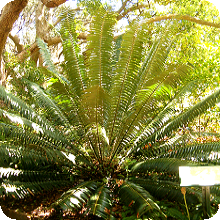|
| Division: Cycadophyta |
| Class: Cycadopsida |
| Order: Cycadales |
| Family: Zamiaceae |
| Genus: Encephalartos |
| Species: E. paucidentatus |
Conservation Status: |

E. paucidentatus
Barberton CycadEncephalartos paucidentatus, also known as the Barberton Cycad, is endemic to the mountains near Barberton in Mpumalanga Province, and near Piggs Peak in the northwestern part of Swaziland, South Africa. This species occurs sparsely on steep, often rocky, slopes in low forest and mountain bush. Plants grow mainly between trees alongside streams in deep gorges.
Growing in regions that are heavily forested with steep rocky slopes and in semi shade, those found on rock cliffs have slender stems while those found growing in semi shaded area have thicker stems which can reach up to 6m in length and 40 to 70cm in diameter. The climate is hot in summer and cold in winter.
The dark green glossy leaves are 1 to 2m long and are flat and straight with the tips of the outer leaves curving gently upwards and inwards, although not to the same extent as in the Heenanii, its close relative. Female cones are a golden yellow colour, heavily wrinkled and covered with a fine golden brown wool which is gradually lost as the cone matures.
The seeds are red.
Cultivation:
Encephalartos paucidentatus is best cultivated in semi shade, although can be grown in full sun. It requires good mulching and water in dry seasons or periods. Mature plants resent disturbances and are slow to re-establish, often taking a number of years before producing a new set of leaves.
| semi-shade | dark green | low watering | slow growth | frost-resistant | uncommon |
Encephalartos paucidentatus is best cultivated in semi shade, although can be grown in full sun. It requires good mulching and water in dry seasons or periods. Mature plants resent disturbances and are slow to re-establish, often taking a number of years before producing a new set of leaves.
E. paucidentatus for sale at AfricaCycads.com:
